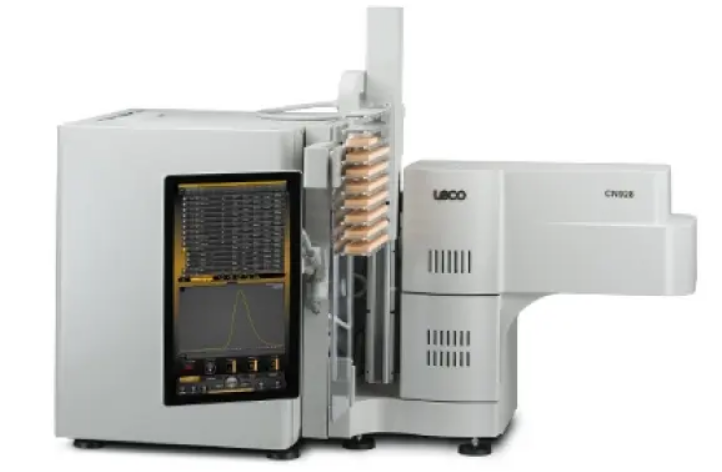928 Series Macro Determinator
Analyze Carbon, Nitrogen, Sulfur, and Proteins by Combustion
With the 928 Series Macro Determinator for detecting Carbon/Nitrogen/Sulfur and Nitrogen/Protein by Combustion, you can easily manage heterogeneous, difficult-to-prepare, or low-analyte-level samples. Throughput, uptime, and dependability are all improved in your laboratory thanks to cutting-edge hardware and our own Cornerstone® touch-screen software platform. The 928 Series is suited for these demanding macro samples because of its macro sample mass capability (up to 3 grammes for Nitrogen/Protein model regardless of sample carbon content), short cycle durations, and low cost-per-analysis.

Features
- Ergonomic, operator-centered design with touch-screen interface positioned on the boom.
- For simpler maintenance, all reagent tubes and common maintenance locations are easily accessible.
- Longer reagent lives contribute to lower per-analysis costs.
- The horizontal furnace design ensures full oxidation of samples at temperatures up to 1450°C.
- With a regent-free design, the furnace’s efficiency and dependability have increased.
Applications
The 928 series is ideal for the following applications: Meats, Feeds, Forage, Pet Foods, Grains, Milled Products, Starch, Fermentation Products, Dairy and Cheese Products, Soils, Sediments, Fertilizers, Plant Tissue, Filtration Media, Waste Materials, Fiber and Textiles, Resins and Polymers, Paper Products, and Petroleum Products and Additives
Theory of Operation
In a variety of organic matrices ranging from meals and feeds to soils and fertilisers, the 928 series determines Nitrogen and Protein (FP928 model), Carbon and Nitrogen (CN928), or Carbon, Nitrogen, and Sulfur (CNS928). The device employs a high-temperature horizontal ceramic combustion furnace that is designed to accommodate enormous sample mass while giving unrivalled application capabilities and throughput.
A macro-sized material is weighed into a ceramic boat and loaded into the 100-position loader to begin an analysis. The sample is transferred to a sealed purge chamber, where entrained atmospheric gas is removed, in a completely automated analytical sequence. The purged sample is automatically delivered to the furnace, which operates at temperatures ranging from 1100°C to 1450°C. The furnace atmosphere is made of pure oxygen with a secondary oxygen flow supplied to the sample via a ceramic lance to enable complete and quick combustion (oxidation).
Before a representative aliquot of the gas is withdrawn and placed into a running stream of inert gas for examination, the gases equilibrate and mix in the ballast. The aliquot gas is sent to a non-dispersive infrared (NDIR) cell for carbon (as carbon dioxide) and sulphur (as sulphur dioxide) detection, and a thermal conductivity (TC) cell for nitrogen detection, depending on the analyzer model (N2). TC cells, unlike NDIR cells, are chemically non-specific, requiring a succession of reagents and scrubbers to ensure quantitative detection of N2 without chemical interference. To reduce nitrogen oxide species (NOx) to N2 and eliminate extra oxygen, a heated reduction tube packed with copper is utilised. LECOSORB removes carbon dioxide (CO2), while Anhydrone removes water (H2O).
Careful sequencing of the analysis by the Cornerstone® brand software provides maximum sample throughput by interleaving the sample loading sequence with quantitation of the aliquot gases from the previous sample. As soon as the combustion gas is collected in the ballast, and the analysis sequence is initiated for the next sample.
Cornerstone displays the sample’s calculated composition in weight percent or parts-per-million, but it can be be displayed in other custom units if desired.
The 928 Series analyzer has a lot of diagnostic sensing capabilities. Multiple pressure transducers ensure that there is enough oxygen and helium in the system, as well as the capacity to leak-check individual flow path segments. MFCs (Mass Flow Controllers) are digital devices that control and measure essential oxygen and helium flows. The temperature of important components such as the furnace, ballast, dosage loop, helium MFC, NDIR cell, and TC cell is thermostatically controlled using thermal sensors and heaters.
